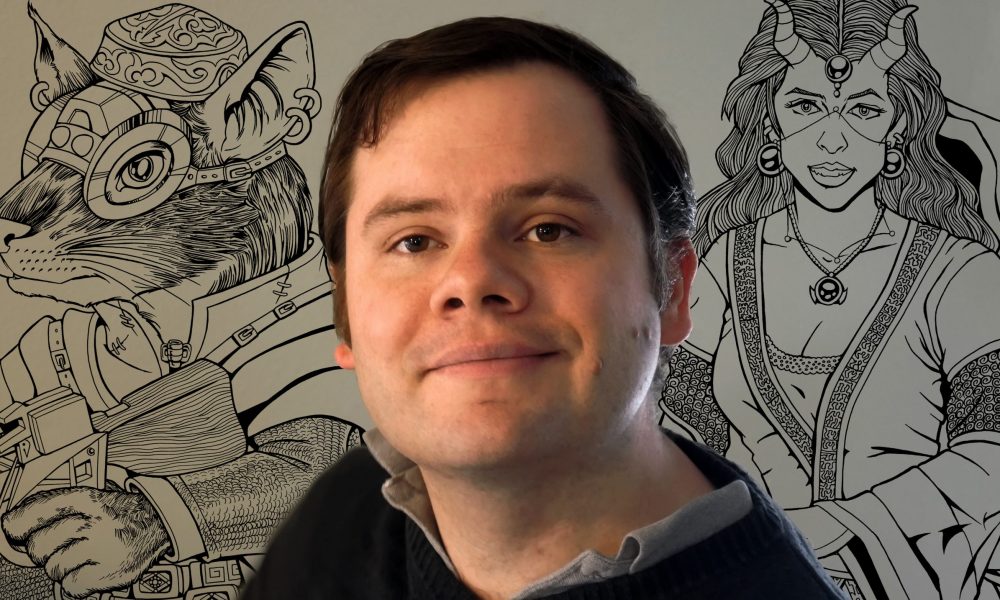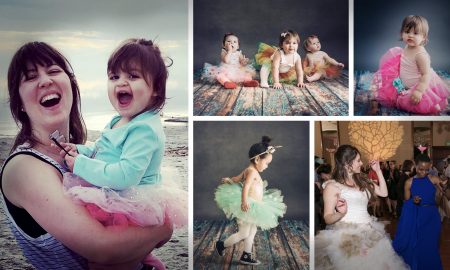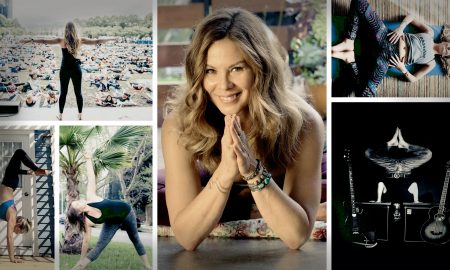

Today we’d like to introduce you to Garrett Gilchrist.
Garrett, please share your story with us. How did you get to where you are today?
I’ve been a writer, artist, and filmmaker for just over twenty years now. In high school, I started a comedy team with my friends because I wanted to make something like Monty Python. I was graduating in the first half of 1999, and directing four feature-length movies, and writing a musical. I wrote these with my friend David, the funniest guy I knew. It was a great way to learn how to make a movie, just going out and doing something dumb.
My parents divorced around when I was twelve, and I was kind of on my own from that point on. I joined an internet forum for no-budget filmmakers. This was way before YouTube. I had no idea that anyone else in the country was making little movies and trading tapes. I felt less alone. Then I moved to Los Angeles to go to USC, which they call the top film school in the country and felt alone again. People weren’t just running around and making movies. They wanted a million dollars first.
Maybe they were right about that. I wasn’t worried about my image like that. I was a little too content to play the fool. I went back to Connecticut over the summer to make two more movies, and it was weirdly stressful. I’m a perfectionist. I wanted to be in control, to make sure it was being done right. I realized I’d been getting angry, losing my temper and yelling at people. Everyone loses respect for you, and you’ve lost. You can’t control a set if you can’t control yourself.
A director should be the nicest person on the set because you’re putting your cast and crew through some very hard work and they’ve got to feel safe to be their best. I was just 19 years old, realizing this. I would shoot a lot of takes on my movies, and make sure I got the shot, but I’d try to be nice about it. Living in Los Angeles taught me to chill out and calm down. Once I did that, though, the years seemed to pass in an eyeblink.
USC would set us loose with MiniDV cameras and see what we came up with. It was an extra challenge to shoot short silent films and not just rely on dialogue. The entire class would critique it pretty mercilessly, and so you had to get serious and get better really fast. I flew out to the Midwest twice, to work with some “underground comedians” I knew, and it was a mistake both times. Even if you’re twenty-two and have no money, with filmmakers, there’s a lot of ego in the room.
I found it hard to shut off my “filmmaker’s brain” and just act. I thought I could help and make the movies better. Instead, you learn really quickly who people really are. Film school was like that too. There was a surprising amount of backstabbing considering we were making five-minute student films that nobody else would ever watch. I had a wonderful teacher at USC for Directing Actors, and he was kind enough to teach everyone in the class at their own skill level.
We had a real pro who’d worked with Richard Donner. And we had complete amateurs. He gave his feedback based on our own skill level, and what we could improve. It was hugely helpful. But we also had a guy in the class who turned in the worst directing job I’ve ever seen. A child could do better. Shot in the dark, all the angles were wrong, you could barely hear the sound. This guy only showed up to class a couple of times, and when he did, he didn’t pay attention. The teacher, who was normally so patient, was furious with him.
After that class, the dinosaur guy got promoted. He was a director. He was in charge. I don’t know the whole story, but he must have had connections somewhere. Sometimes it really was like being in the film industry, complete with the awful politics. People want to be successful, and they think the way to do it is to drag other people down. I tried to help people, but if you’re trying to make a good film that’s going to be stressful and personal and it only takes one person to ruin it for everyone.
Directing is about control, and when I didn’t have control over the final edit, the results were shocking. It didn’t help that we’re all just sort of awful in our early twenties. While at USC I spent three years making a serious feature, still shot on, so it looks like a soap opera. But there was some good stuff in it, some very good actors. If we’d had the technology then that we have now, it would look like an indie film.
But I don’t know if I’d have wanted to live my life on Youtube, like you do these days, and have all of that out there while I’m learning. It’s harder to make mistakes now, and YouTube isn’t a filmmaker’s medium. It doesn’t reward people who put years of time and thought and energy into every project. It’s about uploading every day and yelling at movies or video games. You just become an advertisement.
In some ways, YouTube stole all the energy that amateur filmmaking had at the turn of the century. Nobody’s really going viral as the next big filmmaker, or sketch comedian. It’s hard to find someone who’s doing something small and quirky and interesting.
We used to trade VHS tapes and find out who was out there doing good, funny stuff for no money. We’d have been happy to keep making movies for cheap for years if the bills were paid. We were learning how to make feature films, but Hollywood has changed what a feature film is. They’re spending two hundred million dollars on something where every frame is a special effect. I love seeing a new Marvel movie, or a new Star Wars movie. But it’s not like indie films which help new filmmakers find their own voice.
Growing up in the 90s is that we were preparing, very hard, to get jobs in a world which doesn’t exist anymore.
When I graduated college in 2004, the economy was already crashing. I’d gone to a top film school, but I couldn’t get a job at a shoe store. I sent out a hundred job applications every day without any response, for years. Something had broken in our country that never got fixed. You don’t really see what life is like for people who are poorer than you, or richer than you. They live by completely different rules.
For rich people, the world bends around them. If you’re middle-class, and there isn’t much of a middle class anymore, this economy still sorts of works like it did back in the 90s. If you’re poor, you’re in a trap, and it’s not likely you’ll get out. Poor people are the only people who know anything about money. You’ve seen behind the curtain, and you can’t explain it to anybody because they think the world is fair. We’re ruled almost exclusively by millionaires.
I would often find myself going out to industry parties, surrounded by celebrities, where tens of thousands of dollars were being spent on frivolous things for an hour or two, and then go back to a dirty, noisy apartment with cockroaches and eleven roommates. There’s an understanding that we’re always supposed to be performing and promoting ourselves, playing the part of someone more marketable than we are. The internet and social media can be like that too.
You realize the difference is money – whether you’ve got it or not. And all the best and worst people come to L.A. There are these predators in the distance. We all smile, shake hands and hand out business cards, and it can be hard to tell the difference. But a predator knows. If you’ve ever been a target of abuse, it’s easy for someone who is a psychopath to test your limits and figure you out, as if your emotional scars are visible. And if you’re broke in Los Angeles, you’re going to be meeting some predatory people.
I wrote about fourteen feature film scripts, as well as a short novel, and most of two longer novels. I’d always written screenplays intending to film them myself, but my ideas were increasingly ambitious and seemed to call for an actual Hollywood budget. I emailed hundreds of agents, managers and production companies about my scripts but couldn’t get anyone to read them. I was creating small fan projects on the internet, which sometimes went massively viral. If you’re in certain fandoms, you’ve probably seen my work without knowing it was mine.
In 2005, I made Deleted Magic. The original Star Wars is one of the great editing stories of all time. The footage they shot onset didn’t really work in the edit, and a huge amount of skill was brought to the table in post-production to make that film as good as it ended up being. My documentary explained that, as well as showing what I loved about the films as a kid. That struck a chord with the internet, and it became a viral hit, copied and torrented and bootlegged. It felt like I was the only one not making money off it.
Then they asked if you could re-edit and restore any film, what would it be? I had one answer. A film no one else on that forum had heard of. Except someone I knew wrote me to say that he worked on the film, and had rare footage to share. And that someone definitely should re-edit and restore that film, and that it should be me. This was the beginning of 2006. I finished it eight years later at the end of 2013. I believe it’s the most complex independent restoration of any film ever attempted.
The Thief and the Cobbler is an unfinished animated film by Richard Williams, the three-time Academy Award-winning animator of Who Framed Roger Rabbit. Richard is the author of “The Animator’s Survival Kit.” He literally wrote the book on how to animate, and many consider him the greatest animator alive. He is part of the reason why the Disney films that followed Roger Rabbit are so good because in the 70s Richard hired veteran animators from Disney and Warner Bros like Art Babbitt and Ken Harris to pass on their knowledge to a new generation.
Richard himself wanted to be the next Walt Disney. But he worked mostly in commercials, and on The Thief and the Cobbler, which he spent thirty years on. No one was willing to fully fund the film until the success of Roger Rabbit. Warner Bros-funded the film but got cold feet when Richard went over deadline. He was on track to complete the film but needed six more months. He was arrogant enough to assume that Warners would recognize the value of his work and extend the budget, as had happened on his Oscar-winning films.
But within the animation industry, the film had long been considered both a masterpiece and a joke – something that Richard would never be able to finish. Disney was also “borrowing” the film’s look for Aladdin, and their film was going to release first. Warners got cold feet and fired Richard from his own film. It was never completed as intended, and the Harvey Weinstein-approved released version is a travesty bearing no resemblance to the director’s intentions. I had expected no one to care about reediting this obscure lost masterpiece. I did the edit just for myself.
But people who had worked on the film kept contacting me, and vice versa. They sent me rare materials, building a massive archive of documents and data. The film had always been a cult favorite in the animation industry but was still underappreciated since the released version is so bad and there was no way to watch Richard’s version in a coherent, high-quality edit. I was able to change that, and do something good for the history of the film. My edit is now taught in animation schools, and I’ve been offered teaching positions because of it.
I was able to introduce his film to a lot of new fans, who consider it, in this form, one of the greatest animated films ever made. If I had access to the full versions of the movie on 35mm, I could create something much better and more complete, but I don’t think that will ever happen officially for a lot of reasons. I also restored dozens of rare Muppet specials. A friend unearthed three unaired episodes of Little Muppet Monsters, a Muppet Babies spinoff which featured the whole main Muppet Show cast.
The puppet footage for the season had been filmed, but there were delays with the animation, and only three episodes were completed and aired. Available VHS copies were damaged, and I spent weeks restoring the material. Unseen for thirty years. The best of the episodes was “Gunko,” written by my friend’s fiancee’s late father. A clip from the episode of Kermit typing is now a meme that I see people use on the internet almost every day. I did thousands of projects like this on the side, just so this stuff would be out there where people could see it.
Meanwhile, I’m writing, drawing and filming personal projects. Most of my favorite stuff I’ve ever done has only been seen by me and maybe a few others. I’ve spent years on projects which just sort of fizzle out because there isn’t enough money and time to get it all the way there. In early 2007, I was in Santa Monica at the apartment of someone I knew who had money, and was bored, and wanted to make a film. Trying to spend as little of his money as possible, we shot Shamelessly She-Hulk, about the Marvel comics character.
Marvel Studios movies weren’t even a thing yet. Iron Man was still in shooting. But this was a movie about the Marvel universe, echoing what I loved about those comics. It told her origin story but was also partly a comedy. In the comics, she’d sometimes been aware that she was in a comic book and broke the fourth wall, like a feminist-friendly Deadpool.
So I let the character direct her own film. I got tens of thousands of headshots, called in everyone, and auditioned four hundred people- anyone who would show up and work for free. I found some very talented actors. We spent very little money but made a good little film, focused on character acting. I enjoyed writing a strong and vulnerable woman, both super and human. I couldn’t make money off it and was scared of being sued by Marvel but eventually put the scenes up on YouTube, where they got 12 million views.
In the film, she says “I’m one of the Avengers!” At the time, only comics fans would get that reference. Today everybody would. In 2007, I started an animation project, Whosprites, which was intended to animate the lost episodes of Doctor Who from the 60s. A lot of fans wanted to do that, but there wasn’t a lot of art talent around. So I spent over two years drawing and coloring thousands of animated images of the Doctor Who cast and created over an hour of pilot footage.
The project was popular with fans and got a lot of attention in the press, and I’ve seen projects which kind of copied my art style. But I couldn’t get a real team together of fans to do more full episodes, and I wasn’t hired to do any work on the official DVDs. But I learned a lot doing all that artwork and became an artist full-time. In 2005, I’d created an animated series concept called The Chosen Ones. In 2011, I adapted it into a comic book on the web, producing about 70 pages. It was a crash course in learning how to make a comic. After a year the main story still hadn’t really started yet. I hadn’t written the script for comics.
It’s a lot of work to draw a comic page, and you want it to be fast-paced with action always occurring. There was a lot happening, but because I’d written the script to slowly set up a television series, the pieces of the actual plot weren’t clicking into place fast enough. The strip’s art style was also something of a hodgepodge of cartoony and more realistic styles, and I often used reference as a crutch. But as a whole, the Chosen One’s comic is full of stuff I’m proud of, which was setting up for stuff I’d have been prouder of. I’ve now painted covers and some in-game scenes for two dozen commercially-released video games.
Usually, these are for retro systems, like the ones I played myself as a kid. Colecovision, Intellivision, SNES and now the Nintendo Switch. I’ve also done movie posters, book covers, and promotion. My clients are small companies and individuals. They’re not wealthy, and I can spend weeks getting a finished painting to look just right. I am a perfectionist, and I’ve decided I’ll learn more as an artist the less shortcuts I take. So at this point, the work doesn’t fully pay my bills. But there are months where it gets close if there were more work coming in.
I am a writer, artist, and filmmaker and ideally, I would like to be doing all three on my own creative projects in a very public way. The personal work that I do combines those talents. Sadly a lot of it isn’t public for various reasons, and when it is public, it’s hard to get a lot of people seeing it and build a fanbase. Lately, I’ve been getting back into filmmaking, while also developing a video game project or two. In 2014 and 2015, I intended to Kickstart a big project about a group of women trapped in a dream world based on their own fears.
For me it was an evolution of what I’d been trying to do with The Chosen Ones, but if I’d created that project now. The project was funded, for a while, and I did maybe four months work on it before there wasn’t time and money to continue. I am still out of money, but I’ve been trying to finish what I started. The reality of being a creative artist while trying to pay bills and keep a roof over my head. But I’ve got a lot more to show you, and I hope I’ll be able to keep doing that.
Contact Info:
- Website: http://orangecow.org
- Instagram: https://www.instagram.com/gilchristgarrett
- Facebook: https://www.facebook.com/Garrett-Gilchrist-OrangeCoworg-140626542649/
- Twitter: http://twitter.com/TygerbugGarrett
- Other: http://tygerbug.deviantart.com/gallery



























